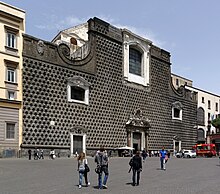Gesù Nuovo
| Church of Gesù Nuovo | |
|---|---|
| Chiesa di Gesù Nuovo | |

The Church of Gesù Nuovo.
|
|
| Coordinates: 40°30′19″N 14°09′02″E / 40.505144°N 14.150649°E | |
| Location | Piazza del Gesù Nuovo Naples Province of Naples, Campania |
| Country | Italy |
| Denomination | Roman Catholic |
| Architecture | |
| Status | Active |
| Architectural type | Church |
| Style | Baroque architecture |
| Completed | 1750 |
| Administration | |
| Diocese | Roman Catholic Archdiocese of Naples |
Gesù Nuovo (Italian New Jesus) is the name of a church and a square in Naples, Italy. They are located just outside the western boundary of the historic center of the city. To the southeast of the spire, one can see a block away the Fountain of Monteoliveto and the piazza of the church of Sant'Anna dei Lombardi. The square is a result of the expansion of the city to the west beginning in the early 16th century under the rule of Spanish viceroy Pedro Alvarez de Toledo. The square of Gesù Nuovo contains three prominent landmarks:
The Church of Gesù Nuovo was originally a palace built in 1470 for Roberto Sanseverino, Prince of Salerno. The Jesuits had already built a church with this name in Naples, now called Gesú Vecchio. Political intrigues by the Sanseverino family caused the property to be confiscated, and eventually sold in the 1580s to the Jesuits for 45,000 ducats to construct a church (1584–1601) under architect Giuseppe Valeriano. The construction was also helped by local support including that of Roberta Carafa, Countess of Maddaloni. The adjacent gardens of Isabella Feltria, Principessa di Bisignano were also included in the construction. Construction of the church began in 1584. The new church retained the unusual facade, originally built for the palace, faced with rustic ashlar diamond projections.
When the Jesuits were expelled from Naples in 1767, the church passed to the Franciscan order. The Jesuits returned in 1821, only to be expelled again in 1848.
The vault frescos, representing biblical and saintly narratives that exalt the name of Jesus, were carried out by Belisario Corenzio and Paolo de Matteis. At the back of the facade is The Expulsion of Heliodorus from the Temple (1725), a baroque masterpiece by Francesco Solimena. On the four pillars which support the dome are frescos of the four Evangelists, carried out by Giovanni Lanfranco. The inside of the dome had also been decorated by Lanfranco, but this was destroyed in the earthquake of 1688. Paolo de Matteis then repainted a new dome. The frescos of the life of the Virgin, placed on the second part of the vault up to the apse, are by Massimo Stanzione.
...
Wikipedia
